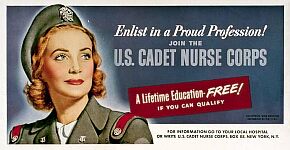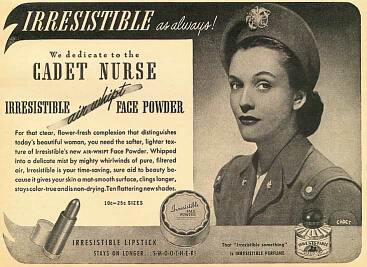|
|
|
. The plans became concrete when Representative Frances Payne Bolton of Ohio introduced a bill on 29 March 1943. .
The Nurse Training Act (known as the Bolton Act) passed through Congress unanimously. The bill was signed by the President on June 15, 1943, and became effective as Public Law 74 on July 1, 1943. .
The Nursing schools throughout the country were informed of the new Corps and invited to join. Schools who wanted to take part in the Cadet Nurse program had to fulfill minimal requirements. The school had to be accredited and be affiliated with a hospital approved by the American College of Surgeons. The staff and the facilities had to be adequate, but superior standards were not required. Schools with substandard conditions were not rejected, but supported with funds from the Corps to improve their training possibilities. When the Cadet Nurse program ended, 1,125 from 1,300 of the Nation’s nursing schools had participated. . Recruitment Campaign . -  Everything was done to convince young women that it would be the best choice for them and their country to join the Corps. There were many other attractive and higher-paying jobs for women available during wartime, and therefore this was no easy task. . .
. A big part of the advertising campaign included the promise that nursing would be a “lifetime education in a proud profession“ with excellent future prospects. In addition, nurses would make “excellent wives and mothers, capable homemakers, and competent leaders in their community.“ It was pointed out that Cadet Nurses received free training with pay – a big attraction for women from poorer social backgrounds to get an education that was unaffordable otherwise. .
. All available media was used for the publicity and recruitment campaign. The Cadet Nurse Corps was featured in movie newsreels, radio soap operas, variety shows, billboards and newspapers. Several advertisements and articles were published in popular magazines like the Cosmopolitan, Collier’s, Vogue, Ladies’ Home Journal and Harper’s Bazaar. Color posters were prominently placed at department stores, post offices, pharmacies, hospitals and schools. Additionally, several million leaflets were distributed all over the country. Cadet Nurses marched in patriotic parades; they were present at launching of Liberty ships and at war-bond rallies. Celebrities like Ms. Eleanor Roosevelt or Ms. Winston Churchill made some appearances with the Cadet Nurses. .# .  . For example, prominent companies who supported the Cadet Nurse Corps were the Eastman Kodak Company, Pond's Cold Cream, Kotex, Kleenex, Pepsi-Cola, Old Spice, Sanka Coffee and National Biscuit Company. Their commercial prestige and wide popularity as wholesome “All-American” companies gave the recruiting effort a big boost.
|

| [Homepage] |